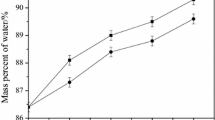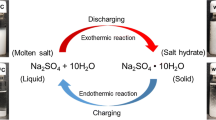Abstract
Aqueous solution of poly(vinyl alcohol) (PVA) forms hydrogels by freezing and thawing. In this study, micro-fibrillated cellulose (MFC) was mixed with PVA aqueous solution. Thermal properties of PVA–MFC composite hydrogels were investigated in a wide range of water content by differential scanning calorimetry (DSC). On DSC heating curves, glass transition, exothermic peak due to cold crystallization and endothermic peak attributed to melting of water were observed. Phase diagrams of PVA–MFC composite hydrogels were established based on transition temperatures. The amount of non-freezing water increased when MFC is introduced into hydrogels. Glass transition temperature of amorphous ice restrained by PVA–MFC composite hydrogel is restricted by the presence of MFC. Results obtained by DSC suggest that gelation occurs in adjacent PVA molecules due to compartmentalization in the presence of MFC molecules.






Similar content being viewed by others
References
Hatakeyama T, Yamauchi A, Hatakeyama H. Studies on bound water in poly(vinyl alcohol) hydrogel by DSC and FT-NMR. Eur Polym J. 1984;20:61–4.
Bhad SN, Sangawar VS. Synthesis and study of PVA based gel electrolyte. Chem Sci Trans. 2012;1:653–7.
Flory PJ. Principles of polymer chemistry, chapter 11. Ithaca, New York: Cornell University Press; 1953.
Peppas NA, Merrill W. Poly(vinyl alcohol) hydrogels: reinforcement of radiation-crosslinked networks by crystallization. J Polym Sci Polym Chem Ed. 1976;14:441–57.
Peppas NA, Merrill EW. Determination of interaction parameter χ1, for poly(vinyl alcohol) and water in gels crosslinked from solutions. J Polym Sci Polym Chem Ed. 1976;14:459–64.
Peppas NA, Merrill EW. Crosslinked poly(vinyl alcohol) hydrogels as swollen elastic networks. J Appl Polym Sci. 1977;21:1763–70.
Hyon S-H, Cha W-I, Ikada Y. Preparation of poly(vinyl alcohol) hydrogels by low temperature crystallization of the aqueous poly(vinyl alcohol) solution. Kobunshi Ronbunshu. 1989;46:673–80.
Nagura M, Hamano T, Ishikawa H. Structure of PVA hydrogel prepared by repeated freezing and melting. Polymer. 1989;30:762–5.
Lozinskii VI, Domotenko LV, Vainerman YES, Rogozhin SV. Some thermomechanical properties of polyvinyl alcohol cryogels. Polym Sci USSR. 1989;31:1983–8.
Mori Y, Tokura H, Yoshikawa M. Properties of hydrogels synthesized by freezing and thawing aqueous polyvinyl alcohol solutions and their application. J Mater Sci. 1997;63:491–6.
Hassan CM, Peppas NA. Structure and applications of PVA hydrogels produced by conventional crosslinking or by freezing/thawing methods (in Biopolymers PVA hydrogels, anionic polymerisation nanocomposites). Adv Polym Sci. 2000;153:37–65.
Hassan CM, Peppas NA. Structure and morphology of freeze/thawed PVA hydrogels. Macromolecules. 2000;33:2472–9.
Mori Y, Tokura H, Yoshikawa M. Properties of hydrogels synthesized by freezing and thawing aqueous polyvinyl alcohol solutions and their applications. J Mater Sci. 1997;32:491–6.
Holloway JL, Lowman AM, Palmese GR. The role of crystallization and phase separation in the formation of physically cross-linked PVA hydrogels. Soft Matter. 2013;9:826–33.
Ricciardi R, Auriemma F, De Rosa C. Structure and properties of poly(vinyl alcohol) hydrogels obtained by freeze/thaw techniques. Macromol Symp. 2005;222:49–63.
Hatakeyema T, Uno J, Yamada C, Kishi A, Hatakeyama H. Gel–sol transition of poly(vinyl alcohol) hydrogels formed by freezing and thawing. Thermochim Acta. 2005;431:144–8.
Jiang S, Liu S, Feng W. PVA hydrogel properties for biomedical application. J Mech Behav Biomed Mater. 2011;4:1228–33.
Liu D, Ma Z, Wang Z, Tian H, Gu M. Biodegradable poly(vinyl alcohol) foams supported by cellulose nanofibrils: processing, structure, and properties. Langmuir. 2014;30:9544–50.
Iijima M, Hatakeyama T, Hatakeyama H. DSC and TMA studies on freezing and thawing gelation of galactomannan polysaccharide. Thermochim Acta. 2012;532:93–7.
Beltman H, Lyklema J. Rheological monitoring of the formation of PVA–congo red gels. Faraday Discuss Chem Soc. 1974;57:92–100.
Shibayama M, Ikkai F, Momura S. Complexation of PVA–Congo red aqueous solution 2. SANS and SAXS studies on sol–gel transition. Macromolecules. 1994;27:6383–8.
Hatakeyama T, Naoi S, Iijima M, Hatakeyama H. Locust bean gum hydrogels formed by freezing and thawing. Macromol Symp. 2005;224:251–62.
Tanaka R, Hatakeyama T, Hatakeyama H. Formation of locust bean gum hydrogel by freezing–thawing. Polym Int. 1998;45:118–26.
Iijima M, Hatakeyama T, Hatakeyama H. Gelation of cassia gum by freezing and thawing. J Therm Anal Calorim. 2013;113:1073–8.
Siro I, Plackett D. Microfibrillated cellulose and new nanocomposite materials: a review. Cellulose. 2010;17:459–94.
Winkworth-Smith C, Foster TJ. General overview of biopolymers: structure, properties, and applications. In: Thomas S, Durand D, Chassenieux C, Jyotishkumar P, editors. Handbook of biopolymer-based materials from blends and composites to gels and complex networks. Boschstr: Wiley-VCH; 2013. p. 7–36.
Stokke DD, Wu Q, Han G. Introduction to wood and natural fiber composites. Chichester: Wiley; 2014.
Pérez S, Mazeau K. Conformations, structures, and morphologies of celluloses. In: Dumitriu S, editor. Polysaccharides structural diversity and functional versatility. 2nd ed. New York: Marcel Dekker; 1998. p. 41–68.
Iwamoto S, Nakagaito AN, Yano H, Nogi M. Optically transparent composites reinforced with plant fiber-based nanofibers. Appl Phys. 2005;A81:1109–12.
Nakagaito AN, Iwamoto S, Yano H. Bacterial cellulose: the ultimate nano-scalar cellulose morphology for the production of high-strength composites. Appl Phys. 2005;A80:93–7.
Nakagaito AN, Yano H. Novel high-strength biocomposites based on microfibrillated cellulose having nano-order-unit weblike network structure. Appl Phys. 2005;A80:155–9.
Jimena SG, Leandro NL, Alejandra P, Alvarez VA. Poly(vinyl alcohol)/cellulose nanowhiskers nanocomposite hydrogels for potential wound dressings. Mater Sci Eng. 2014;C 34:54–61.
Hatakeyama H, Hatakeyama T. Interaction between water and hydrophilic polymers. Thermochim Acta. 1998;308:3–22.
Hatakeyama T, Tanaka M, Hatakeyama H. Thermal properties of freezing bound water restrained by polysaccharides. J Biomater Sci. 2010;21:1865–75.
Hatakeyama T, Inui Y, Iijima M, Hatakeyama H. Bound water restrained by nanocellulose fibres. J Therm Anal Calorim. 2013;113:1019–25.
Hatakeyama T, Quinn FX. Thermal analysis fundamentals and applications to polymer science. 2nd ed. Chichester: Wiley; 1999.
Hatakeyama T, Hatakeyama H. Thermal properties of green polymers and biocomposites. Netherlands: Kluwer Academic; 2004.
Hatakeyama T, Iijima M, Hatakeyama H. Role of bound water on structural change of water insoluble polysaccharides. Food Hydrocoll. 2015. doi: 10.1016/j.foodhyd.2014.12.033.
Yoshida H, Hatakeyama T, Hatakeyama H. Effect of water on the main chain motion of polysaccharide hydrogels. In: Glasser WG, Hatakeyama H, editors. Viscoelasticity of biomaterials. ACS symposium series, vol. 489. Washington, DC: ACS; 1992. p. 218–30.
Hatakeyama T, Tanaka M, Kishi A, Hatakeyama H. Comparison of measurement techniques for identification of bound water restrained by polymers. Thermochim Acta. 2012;532:159–63.
Kishi A, Tanaka M, Mochizuki A. Comparative study on water structures in polyHEMA and polyMEA by XRD–DSC simultaneous measurement. J Appl Polym Sci. 2009;111:476–81.
Acknowledgements
The authors are grateful to Professor Clive S. Langham, Nihon University, for his helpful advice. This work was supported by a Grant-in-Aid for Scientific Research [Young Scientists (B)].
Author information
Authors and Affiliations
Corresponding author
Rights and permissions
About this article
Cite this article
Iijima, M., Kosaka, S., Hatakeyama, T. et al. Phase transition of poly(vinyl alcohol) hydrogel filled with micro-fibrillated cellulose. J Therm Anal Calorim 123, 1809–1815 (2016). https://doi.org/10.1007/s10973-015-4725-7
Received:
Accepted:
Published:
Issue Date:
DOI: https://doi.org/10.1007/s10973-015-4725-7




